USING LONG DIVISION
Subscribe to our ▶️ YouTube channel 🔴 for the latest videos, updates, and tips.
Sometimes we may find it difficult to divide a number by another number using simplification. In that kind of situations, long division will be used.
In this section, we are going to see, how long division can be used to divide a number by another number.
The method for long division is given by

Example 1 :
A local zoo had a total of 98,464 visitors last year. The zoo was open every day except three holidays. On average, how many visitors did the zoo have each day?
Solution :
Total number of days in an ordinary year = 365.
The zoo was open every day except three holidays.
So, total number of days that zoo opened = 362.
Total number of visitors in the year = 98646.
Therefore, number of visitors visited the zoo each day is nothing but the quotient when we divide 98464 by 362.
Let us use long division to estimate the quotient when we divide 98464 by 362.
Step 1 :
362 is greater than 9 and 98, so divide 984 by 362. Place the first digit in the quotient in the hundreds place. Multiply 2 by 362 and place the product under 984. Subtract.

Step 2 :
Bring down the tens digit. Divide 2,606 by 362. Multiply 7 by 362 and place the product under 2,606. Subtract.
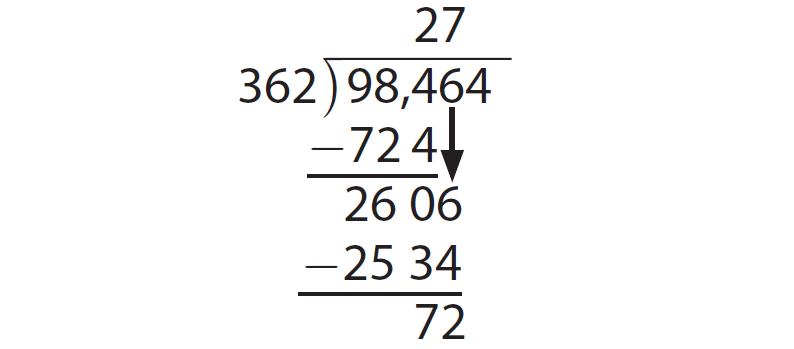
Step 3 :
Bring down the ones digit. Divide the ones.
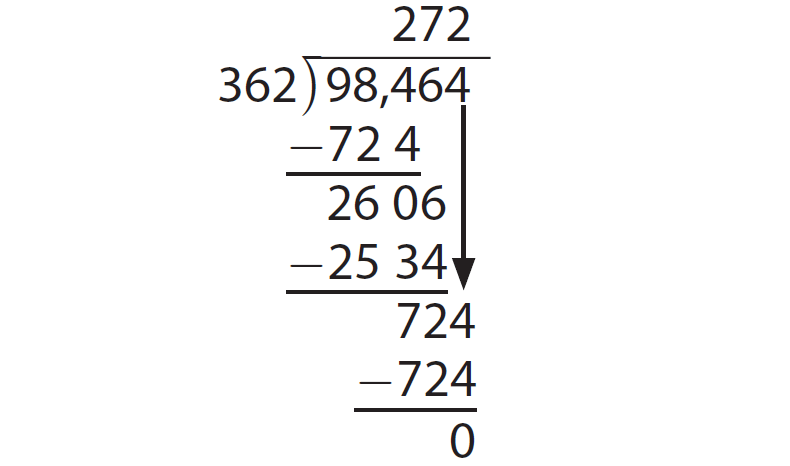
When we divide 98464 by 362, we get the quotient 272.
Hence, the average number of visitors per day last year was 272.
Example 2 :
Marco paid $39 for 8 tubes of oil paint. About how much did each tube cost?
Solution :
Cost of each tube is nothing but the quotient when we divide 39 by 8.
Let us use long division to estimate the quotient when we divide 39 by 8.
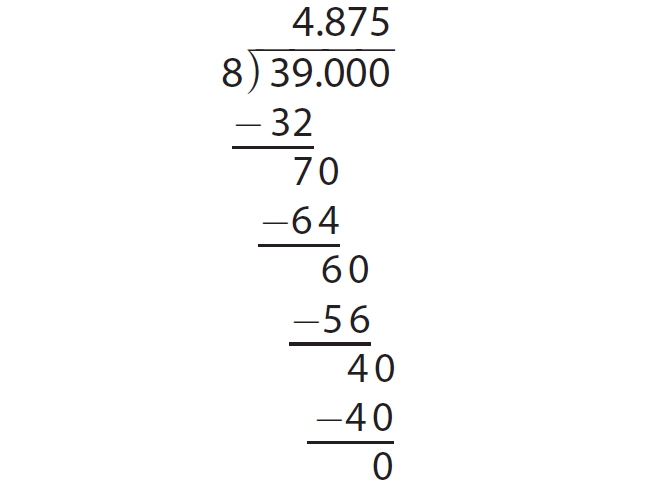
Since 39 is not evenly divisible by 8, place a decimal point in the quotient. Add zeros to the right of the decimal point as needed.
Round to the nearest hundredth to find the dollar amount.
Therefore, the cost of each tube is about $4.88.
Example 3 :
A school track is 9.76 meters wide. It is divided into 8 lanes of equal width. How wide is each lane ?
Solution :
The width of each lane is nothing but the quotient when we divide 9.76 by 8.
Let us use long division to estimate the quotient when we divide 9.76 by 8.
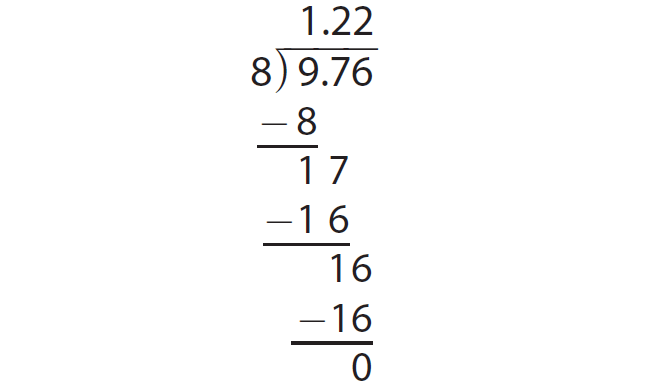
When we use the digit which comes after the decimal point, place a decimal point in the quotient directly above the decimal point in the dividend.
Therefore, each lane is 1.22 meters wide.
Example 4 :
Aerobics classes cost $153.86 for 14 sessions. What is the fee for one session ?
Solution :
The fee for one session is nothing but the quotient when we divide 153.86 by 14.
Let us use long division to estimate the quotient when we divide 153.86 by 14.
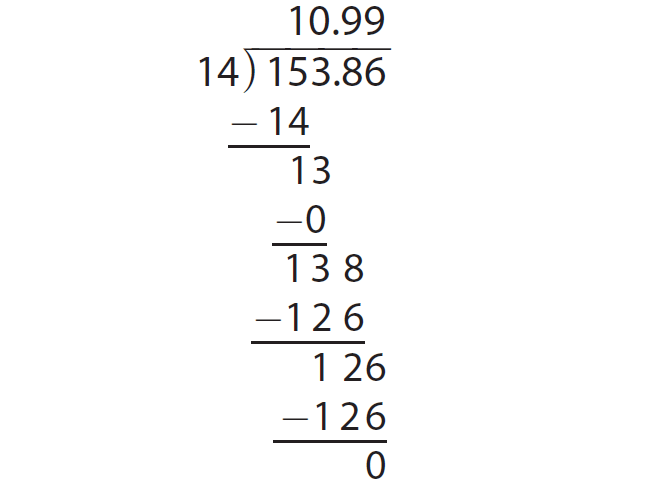
When we use the digit which comes after the decimal point, place a decimal point in the quotient directly above the decimal point in the dividend.
Therefore, the fee for one aerobics class is $10.99.
Example 5 :
Callie has 1,850 books. She must pack them into boxes to ship to a bookstore. Each box holds 12 books. How many boxes will she need to pack all of the books ?
Solution :
To find the number of boxed that she needs to pack all of the books, we have to divide 1850 by 12.
So, let us divide 1850 by 12 using long division.
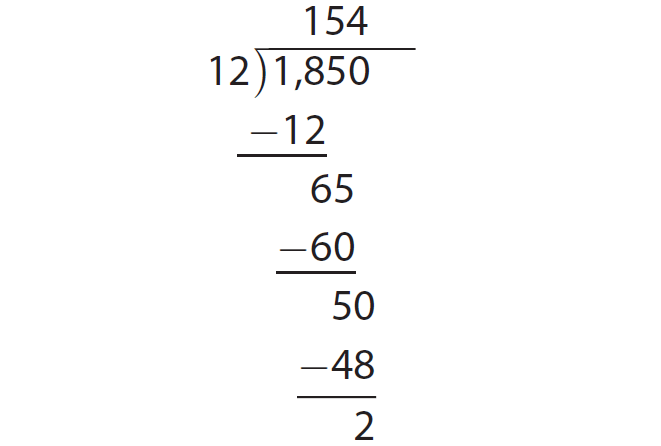
From the above long division, we get
Quotient = 154
Remainder = 2
Callie can pack the books in 154 boxes perfectly and with 2 books left. So, she needs 155 boxes to pack all the books.
Example 6 :
A packet of crayons contains 25 crayons. If 6482 crayons are to be packed equally, how many packets are required ? Will there be any crayons left ?
Solution :
Number of crayons will be in each packet = 25
Number of crayonas available = 6482
Dividing 6482 by 25, we get

Number of packets = 259
Number of packet left = 7
Example 7 :
For a party 125 chairs are required and these chairs are to be arranged in 5 rows. How many chairs will be arranged in a row ?
Solution :
Number of chairs required = 125
Number of rows to be arranged equally = 5
By dividing number of chairs by number of rows, we will get to know how many chairs will be there in a row.
= 125/5
= 25 chairs
So, there must be 25 chairs in a row.
Example 8 :
There will be 1047 marbles with pankaj and he wants to pack them in 9 boxes. What is the number of marbles in each box ?How many marbles are left over.
Solution :
Number of marbles = 1047
Number of boxes to be packed equally = 9
Number of marbles in each box = 1047/9

Number of marbles in each box = 116
Number of marbles left = 3
Example 9 :
Find the quotient and remaimder without doing long division.
a) 8000 ÷ 1000
b) 5066 ÷ 1000
c) 356 ÷ 100
d) 2444 ÷ 100
e) 6000 ÷ 100
Solution :
a) 8000 ÷ 1000
Quotient = 8, remainder = 0
b) 5066 ÷ 1000
Quotient = 5, remainder = 66
c) 356 ÷ 100
Quotient = 3, remainder = 56
d) 2444 ÷ 100
Quotient = 24, remainder = 44
e) 6000 ÷ 100
Quotient = 60, remainder = 0
Subscribe to our ▶️ YouTube channel 🔴 for the latest videos, updates, and tips.
Kindly mail your feedback to v4formath@gmail.com
We always appreciate your feedback.
About Us | Contact Us | Privacy Policy
©All rights reserved. onlinemath4all.com
Recent Articles
-
Quantitative Reasoning Questions and Answers
Dec 14, 25 06:42 AM
Quantitative Reasoning Questions and Answers -
Specifying Units of Measure
Dec 14, 25 06:38 AM
Specifying Units of Measure -
Coin Tossing Probability
Dec 13, 25 10:11 AM
Coin Tossing Probability - Concept - Sample Space - Formula - Solved Problems